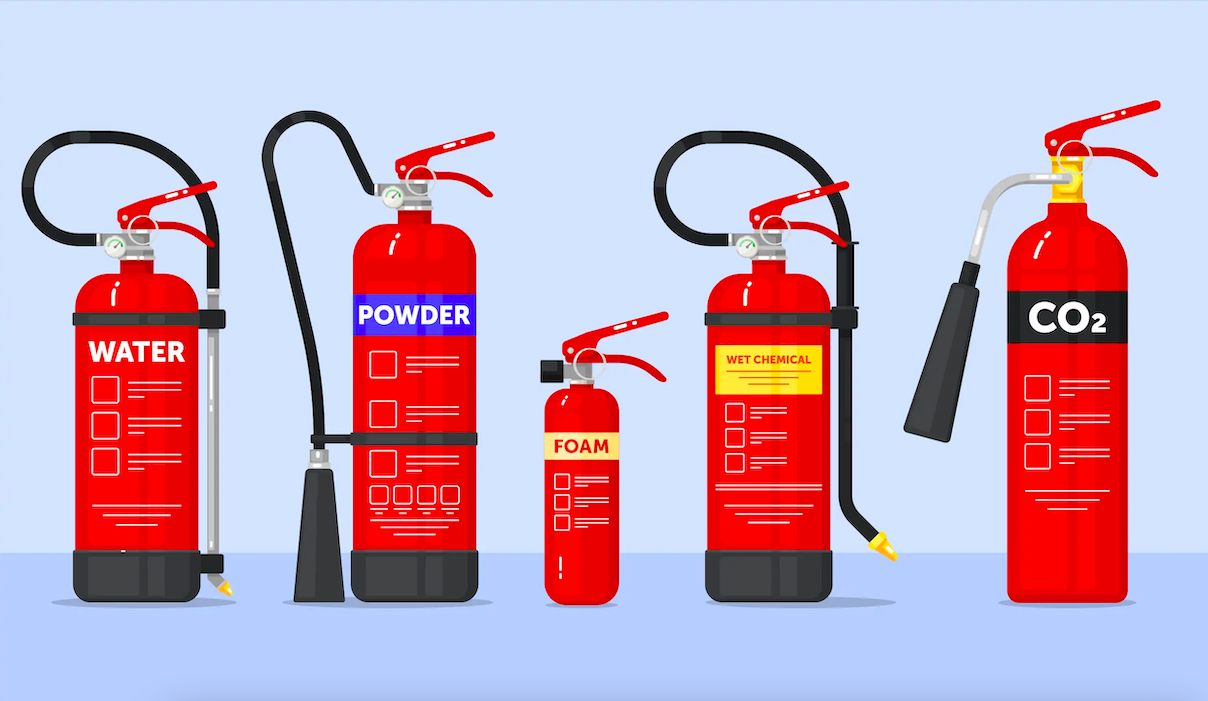Understanding the different types of fire extinguishers is crucial for safety in homes, businesses, and industrial environments. According to the Fire Industry Association (FIA), 93% of fires were successfully controlled using portable ones in the UK in 2021. This emphasizes the importance of having the correct fire extinguisher on-site and ensuring staff receive proper fire extinguisher training.
When employees are trained in using it, they can safely extinguish small fires or create a safe escape route, minimizing property damage, business disruption, and potential loss of life.

Fires are categorized into specific classes depending on the fuel involved:
Class A Fires: Solid combustibles like wood, paper, fabric, and coal.
Class B Fires: Flammable liquids such as petrol, diesel, paint, and turpentine.
Class C Fires: Flammable gases including methane, propane, butane, and hydrogen.
Class D Fires: Combustible metals like titanium, potassium, aluminium, and magnesium.
Class F Fires: Cooking oils and fats.
Electrical Fires: Fires involving live electrical equipment. While not a separate class, they require specific extinguishers identified with an electric spark symbol.
Lithium-ion Battery Fires: Lithium-ion batteries are highly flammable and require specialized extinguishers.
1. Water Fire Extinguisher
Ideal for Class A fires involving materials such as wood, paper, and textiles. They spray water at high pressure to cool the flames and suppress the fire.
Do not use on Class B, C, D, F, or electrical fires.
Common in schools, hospitals, offices, and retail spaces across the UK.
2. Water Mist Fire Extinguisher
Dry water mist extinguishers, release a fine spray that is effective on multiple fire types:
Safe for Class A and F fires.
Can be used on live electrical equipment (up to 1000V at 1-meter distance).
Not suitable for Class D fires.
3. Foam Fire Extinguisher
Class B fires involving flammable liquids.
Also effective on Class A fires.
Do not use on Class C, D, or electrical fires.
Common in workplaces storing flammable liquids, such as warehouses and schools.
4. CO2 Fire Extinguisher
Electrical fires in server rooms, offices, and areas with sensitive equipment.
Also suitable for Class B fires.
Do not use on Class A, C, or D fires.
Use caution in confined spaces due to oxygen displacement risk. Avoid holding the horn to prevent frostbite.
5. Wet Chemical Fire Extinguisher
Class F fires involving cooking oils and fats.
Can also tackle Class A fires, though water or foam may be more appropriate.
Do not use on electrical, Class B, or Class C fires.
Common in commercial kitchens, restaurants, and cafeterias.
6. DCP Dry Powder Fire Extinguisher
DCP Dry powder fire extinguishers are highly versatile and effective for:
Class A, B, C fires and live electrical equipment.
Interrupt chemical reactions by coating the fuel with powder.
Not suitable for Class D fires or enclosed spaces due to inhalation risks.
Often found in garages, welding shops, and boiler rooms.
7. Dry Powder L2/M28 Extinguisher
Class D fires involving combustible metals.
L2 is effective on lithium metal fires; M28 is not.
Not effective for any other fire class.
Essential in industrial, manufacturing, and laboratory environments.
8. Lith-Ex Extinguisher
Lithium-ion battery fires.
Also suitable for Class A fires and live electrical fires.
Do not use on Class B or F fires.
Crucial in facilities storing or using lithium-ion batteries.
Maintenance Responsibilities
The responsibility for maintaining extinguishers varies by business. Often, a Fire Marshal or Fire Warden oversees maintenance. In businesses without a designated person, it is advisable for staff to undergo certified Fire Marshal Training to ensure fire safety compliance and readiness. Choosing the correct fire extinguisher type and ensuring proper training is essential for safety and compliance. Each extinguisher is designed to combat specific fire classes effectively. Businesses must regularly assess their fire safety equipment and staff training to ensure they are prepared for any fire emergency.
